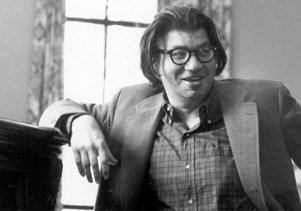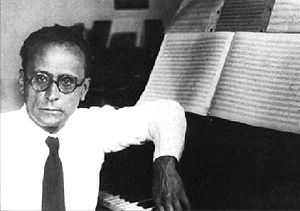

[This is another chapter in the “Morton Feldman speaks with …” series. I’m thinking that I may do several of these.]
It’s a famous story that John Cage and Morton Feldman met when both were walking out of a concert of the New York Philharmonic in 1950. They had just heard Webern’s Symphony, Op. 21 and neither cared to stay for the Tchaikovsky that was next on the program. A lifelong friendship was formed that evening, one that changed music. It is commonplace to cite Cage as one who shaped Feldman’s work, but I believe that Feldman was as much or more a shaping force on Cage’s work. Cage himself described Feldman’s first graph piece, Projection 1, as opening a door into another world of music: the world, in fact, in which Cage discovered chance operations.
The American Symphony Orchestra was smart enough to include the Webern Symphony on its Cage tribute program last year, as a way of celebrating this historic event in Cage’s life. It was followed by Feldman’s Out of ‘Last pieces’ (1961) and Cage’s Cheap imitation (1969), but what I really wanted to hear after the Op. 21 was the music they were writing in the early 1950s, from the time that they paid Philharmonic prices to hear Webern and then walked out at intermission. After the Webern was over, I imagined the opening of the Cage Concerto for prepared piano and chamber orchestra (1950-51), the piece he was writing at the time. Hearing those two next to each other is a real ear-opener. And the same can be true for listening to Webern and early Feldman. The other day I decided to explore this a little further. I listened to the Webern Symphony again, then to two Feldman pieces from the time of that famous concert walk-out: Projection 1 for cello (1950) and Structures for string quartet (1951).
Projection 1 is the first graph piece, the one that Feldman sketched in Cage’s living room, the one that opened the door for Cage to chance. Because the notation works by dividing the pitch range into high, medium, and low, I have always tended to focus on register in the piece. But after the Webern, I heard something else: line. The mix of arco and pizzicato makes us hear these almost like two different lines, and we connect the arco notes into phrases. These are mostly two note phrases, which I find particularly Webern-esque. The heavy use of pizzicato in Projection made me hear the quite prominent harp part of the Webern quite differently, too. It would be an interesting experiment to play the Projection along with some other mid-century music for someone who knew nothing about the score of the piece and see what they heard. I think that we’re so conditioned to seeing that piece as a graph that we don’t actually listen to it, or even really hear it (I know that my first unthinking reaction is to start sorting the pitches into bins).
Listening to Structures was a similar experience: the texture and lines of the opening were very reminiscent of Webern. The string writing here shows the kind of very subtle differentiation of attacks and durations that is a key to Feldman’s style. There is a continuum of sounds from pizzicato to very short staccato to longer tones, all applied like brushstrokes on the silence. Going back to the Symphony, I hear something quite similar in Webern, which I never noticed before. It’s heavier and richer in Webern: I can hear Mahler and Schoenberg in his sound, especially in the first movement. Webern has heavier paint and a heavier stroke, even while he is maintains a subtlety of nuance and an airiness of texture that is his own contribution to that period.
The feature of Structures that will jump out at any listener who is familiar with Feldman’s other music is the use of repetition. This is such a prominent trait in the great, late Feldman pieces that to find it also present in such an early work leads one’s mind to jump to conclusions about a unity of early and late styles, or of seeing the magnificent scale of the late works latent in these early miniatures. I’m not so sure about that, myself. The connection that struck me instead was to the places where motives repeated in the second movement of Webern’s Symphony: it’s so rare that it jumps out at you. Listening to that and then to Feldman’s delicate repeating patterns makes you wonder a bit, even if you can’t put your finger on an “influence” here.
But influence is largely a misguided way to think about artists anyway. Feldman grouped Webern with Kafka and Mondrian as artists who were imitated, not followed:
For me, these men are what the Oral Law must have been to the early Hebrews, a sort of moral legend of the uninfluential, handed down by word of mouth. It may sound paradoxical, but Kafka, Mondrian, and Webern have never been influential. It’s their imitators that are influential.
For Feldman, the “stereotyped complexities” of Webern’s imitators ruined the effect of Webern’s music. The Op. 21 no longer shocked him; it’s image was “blurred, so almost submerged in the cultural inundation that has engulfed it.” I’m not sure I agree with him. Or perhaps it is Feldman’s music that restores the clarity to Webern?
